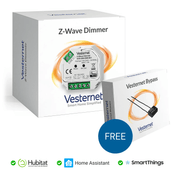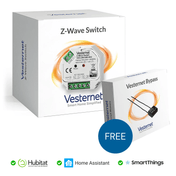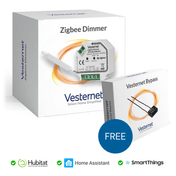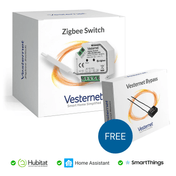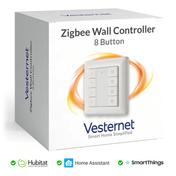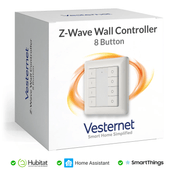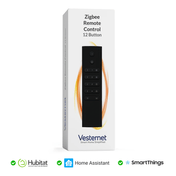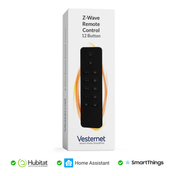Z-Wave & Zigbee modules can be used with a variety of switch types. This guide explains how most modules can be used with Momentary, Toggle and Center-Off-Retractive (3-Position Momentary) switches.
Toggle Switches
Toggle (Bi-Stable) switches latch in position. For instance when you press the switch to On, the switch physically stays in the On position. These are the standard light switches you'll find already fitted in your home.
You can use these in two ways, depending if you would just like On/Off control of the light or you would also like to control the light's brightness from the switch
On/Off Control
Using a toggle switch in this configuration will enable you to manually control the light On and Off, just the same as a normal On/Off switch.
- ON (bottom) - Turns light On
- OFF (top) - Turns light Off
Dimming Control
As strange is it sounds, a toggle switch can also be used with some Z-Wave Dimmer modules to control the light's brightness. Although this may at first appear a little unconventional.
- ON/OFF (Quickly) - Turns light On to previously set dim level
- ON - Increases brightness, turn switch Off to keep light at the brightness level
- ON - Decreases brightness, turn switch Off to keep light at the brightness level
- ON/OFF (Quickly) - Turns light Off
You'll need to check the manual for your specific Z-Wave module and see which device Parameters need changing to support Toggle switches.
Momentary Switches
Momentary switches, also known as Retractive, Mono-Stable or Bell-Push, only remain in the On state while you press them, they return to the Off state when the button is released. This doesn't mean that you have to keep holding the button to keep the light on. The module's internal controls automatically keep the light on when the button is released.
- ON (and release) - Turns light On to previously set dim level
- ON (and hold) - Increases brightness, release switch to keep light at the brightness level
- ON (and hold) - Decreases brightness, release switch to keep light at the brightness level
- ON (and release) - Turns light Off
Note: Some modules will cycle the dim level while you are holding the switch ON
You'll need to check the manual for your specific Z-Wave module and see which device Parameters need changing to support Momentary switches.
Center-Off-Retractive (3-Position Momentary) Switch
A Center-Off-Retractive switch, also known as 3-Position Momentary, Roller Blind or up / down switch has 3 positions - ON / OFF / ON. It normally stays in the central (Off) position, you can then press the top or bottom parts of the switch to move it into the On positions. As this is a momentary (retractive) switch, it only remains in the On state while you press it, it returns to the central Off state when the button is released.
- Top ON (and release) - turns light On previously set dim level
- Top ON (and hold) - increases brightness, releasing it keeps the lamp at that brightness
- Bottom ON (and hold) - decreases brightness, releasing it keeps the lamp at that brightness
- Bottom ON (and release) - turns light off
Note: Not all Z-Wave modules fully support Center-Off-Retractive switches, if yours doesn't then it's still possible to use them but they will operate like two separate momentary switches attached to the same input.
You'll need to check the manual for your specific Z-Wave module and see which device Parameters need changing to support Center-Off-Retractive switches.
Where to get Switches?
There are a variety of vendors offering switches, these include Scolmore, MK Electric, Clipsal and British General.
For Vesternet's videos and testing we've used the Scolmore Click Minigrid range. They are available in different finishes and look good.
As they are a 'minigrid' range you select the components and then assemble them yourself - this enables you to select just the configuration you want:
- Choose the faceplate - finish and number of gangs (switches)
- Select the switch ingots (switch inserts)
- Build the switch by adding the switch ingots to the faceplate
 Figure 1: Minigrid Faceplate and Switch Ingot - unassembled
Figure 1: Minigrid Faceplate and Switch Ingot - unassembled
 Figure 2: Minigrid 3-gang switch - assembled
Figure 2: Minigrid 3-gang switch - assembled
 Figure 3: Minigrid 3-gang switch - rear view
Figure 3: Minigrid 3-gang switch - rear view
For this example we used Scolmore Click Define components:
- 3-gang faceplate (brushed steel) - FPBS401BK
- 10AX 2-way Retractive (Momentary) Switch Ingots - MD004BS
Switch Manufacturer Information
Further information on the manufacturer's switch ranges is available at:
- Scolmore - Click Define range
- MK Electric - Superswitch Grid range (page 21)
- British General - Nexus Grid range
Switch types that cannot be used with Z-Wave Dimmer modules
You should only use the switch types shown above with Z-Wave Dimmer modules.
Other switches such as conventional dimmer switches and 'electronic' switches should not be used.
Conventional Dimmer Switches
Conventional dimmer switches cannot be used as they will conflict with the dimming action of the Z-Wave module.
Electronic Switches
These are switches such as touch sensitive switches or switches with LEDs.
They cannot be used with most Z-Wave dimmer modules as the switch connections cannot provide power to the electronic switch.
Copyright Vesternet 2017
Updated: 24/05/2017









